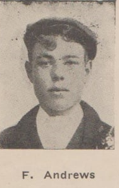
LOWER, Francis George Andrew
| Service Number: | 4556 |
|---|---|
| Enlisted: | Not yet discovered |
| Last Rank: | Private |
| Last Unit: | 16th Infantry Battalion (WW1) |
| Born: | Brighton, England, date not yet discovered |
| Home Town: | Boonah, Scenic Rim, Queensland |
| Schooling: | Not yet discovered |
| Occupation: | Engine Driver |
| Died: | Died of Wounds, Belgium, 5 October 1916, age not yet discovered |
| Cemetery: |
Reninghelst New Military Cemetery, Belgium Reninghelst New Military Cemetery, Reninghelst, Flanders, Belgium |
| Memorials: | Australian War Memorial Roll of Honour, Boonah War Memorial |
World War 1 Service
| 12 Feb 1916: | Involvement Private, 4556, 16th Infantry Battalion (WW1), --- :embarkation_roll: roll_number: '12' embarkation_place: Fremantle embarkation_ship: HMAT Miltiades embarkation_ship_number: A28 public_note: '' | |
|---|---|---|
| 12 Feb 1916: | Embarked Private, 4556, 16th Infantry Battalion (WW1), HMAT Miltiades, Fremantle |
Narrative
Francis (Frank) George ANDREWS aka Francis George Andrew LOWER #3006 and #4556
Frank Andrews, as he was known in Boonah had been born in Brighton, England. He was employed as an engine driver for Queensland Railways, in all likelihood stationed at the engine shed at Dugandan. Frank enlisted in Brisbane on 24th September 1915 where he stated his age as 31 years. He named his sister, Mrs A Lower of Brighton England as his next of kin.
Frank was drafted as a reinforcement for the 25th Battalion with the regimental number of 3006. He sailed for overseas on the “Itonus” from Brisbane on 30th December 1915. When the “Itonus” berthed at Fremantle, WA, Frank was transferred to the 14th reinforcements of the 16th Battalion, presumably at his own request. A second set of attestation papers were completed and he recived a new regimental number; 4556. Frank departed Fremantle on 12th February 1916 and landed in Egypt a month later.
In early 1916, the Australian Imperial Force was going through a period of expansion with the entire force being doubled in size. The Gallipoli veterans of the 16th battalion were split to form the nucleus of two new battalions, the 16th and the 48th. New reinforcements such as Frank Andrews were taken on strength to build up the numbers of each battalion to close to 1000 men of all ranks.
After a period of training in Egypt, the 16th Battalion as part of the 4th Brigade of the 4th Division crossed the Mediterranean to Marseilles and then to the trenches of the Western Front. During July and August 1916, the 16th saw action at Pozieres and Mouquet Farm as part of the Somme campaign, suffering significant casualties.
In September, the 4th Division were withdrawn from the Somme and went into training in the area around Ypres (Iper) in Belgian Flanders. At the end of September the battalion was back in the line at Dickebusch, south west of Ypres. The battalion war diary records that on the 5th October, the Germans put up a sustained barrage of trench mortars followed by a trench raid on the positions occupied by the 16th Battalion. The diary records the death of 6 ordinary ranks and a further 8 wounded during the raid. One of those wounded was Frank Andrews who had received gunshot wounds to both legs. He was transported to a casualty clearing station where he succumbed to his wounds, being buried at the Reninghelst New Military Cemetery south of Poperinghe.
When Frank’s sister, as next of kin, was advised of his death, she wrote to the Australian authorities to advise them that Frank Andrews real name was Francis George Andrew LOWER. The authorities accepted the proof provided and his correct surname was inserted in the official records.
In Boonah, Frank was only known by the name of ANDREWS and this is how his name is recorded on the Boonah Memorial and the Australian War Memorial. His headstone at Reninghelst reads LOWER served as ANDREWS.
Submitted 26 March 2021 by Ian Lang
Biography contributed by Robert Kearney
Enlisted and served under alias Francis George Andrews









